Online learning platform Udemy (NASDAQ:UDMY) beat analysts' expectations in Q1 CY2024, with revenue up 11.6% year on year to $196.8 million. On the other hand, next quarter's revenue guidance of $193.5 million was less impressive, coming in 1.1% below analysts' estimates. It made a non-GAAP profit of $0.03 per share, improving from its loss of $0.06 per share in the same quarter last year.
Udemy (UDMY) Q1 CY2024 Highlights:
- Revenue: $196.8 million vs analyst estimates of $194.9 million (small beat)
- EPS (non-GAAP): $0.03 vs analyst estimates of -$0.01 ($0.04 beat)
- Revenue Guidance for Q2 CY2024 is $193.5 million at the midpoint, below analyst estimates of $195.6 million
- The company reconfirmed its revenue guidance for the full year of $800 million at the midpoint
- Gross Margin (GAAP): 61.2%, up from 56.5% in the same quarter last year
- Free Cash Flow of $17.51 million is up from -$10.58 million in the previous quarter
- Monthly Active Buyers: 1.44 million, up 50,000 year on year
- Market Capitalization: $1.54 billion
With courses ranging from investing to cooking to computer programming, Udemy (NASDAQ:UDMY) is an online learning platform that connects learners with expert instructors who specialize in a wide range of topics.
The company’s key offering is its marketplace of diverse courses. Consumers turn to the platform to learn new skills or brush up on existing ones for professional or leisure purposes. You can take a data analysis course in the morning to improve your performance at work and a photography class at night because it’s a hobby!
Udemy addresses two customer pain points of learning: convenience and selection. First, learning traditionally involved a physical presence. Some people don’t have the time or resources to go to the local community college three times a week in the afternoon to learn music production, for example. Secondly, it is sometimes hard to find a high-quality instructor in a local area. Udemy digitizes learning and acts as a marketplace, allowing consumers to learn from anywhere they have an internet connection and to choose from a vast selection of instructors all over the world.
Udemy generates revenue through a revenue-sharing model with instructors. Instructors create courses and upload them to the platform, and Udemy takes a percentage of the revenue generated from the course sales. In addition, Udemy also offers a subscription service called Udemy Pro, which provides access to a curated selection of courses along with exclusive features and benefits.
Consumer Subscription
Consumers today expect goods and services to be hyper-personalized and on demand. Whether it be what music they listen to, what movie they watch, or even finding a date, online consumer businesses are expected to delight their customers with simple user interfaces that magically fulfill demand. Subscription models have further increased usage and stickiness of many online consumer services.
Competitors offering online educational services include Coursera (NYSE:COUR), Microsoft’s LinkedIn Learning (NYSE:MSFT), and Skillsoft (NYSE:SKIL).Sales Growth
Udemy's revenue growth over the last three years has been mediocre, averaging 17.6% annually. This quarter, Udemy reported mediocre 11.6% year-on-year revenue growth, in line with analysts' expectations.
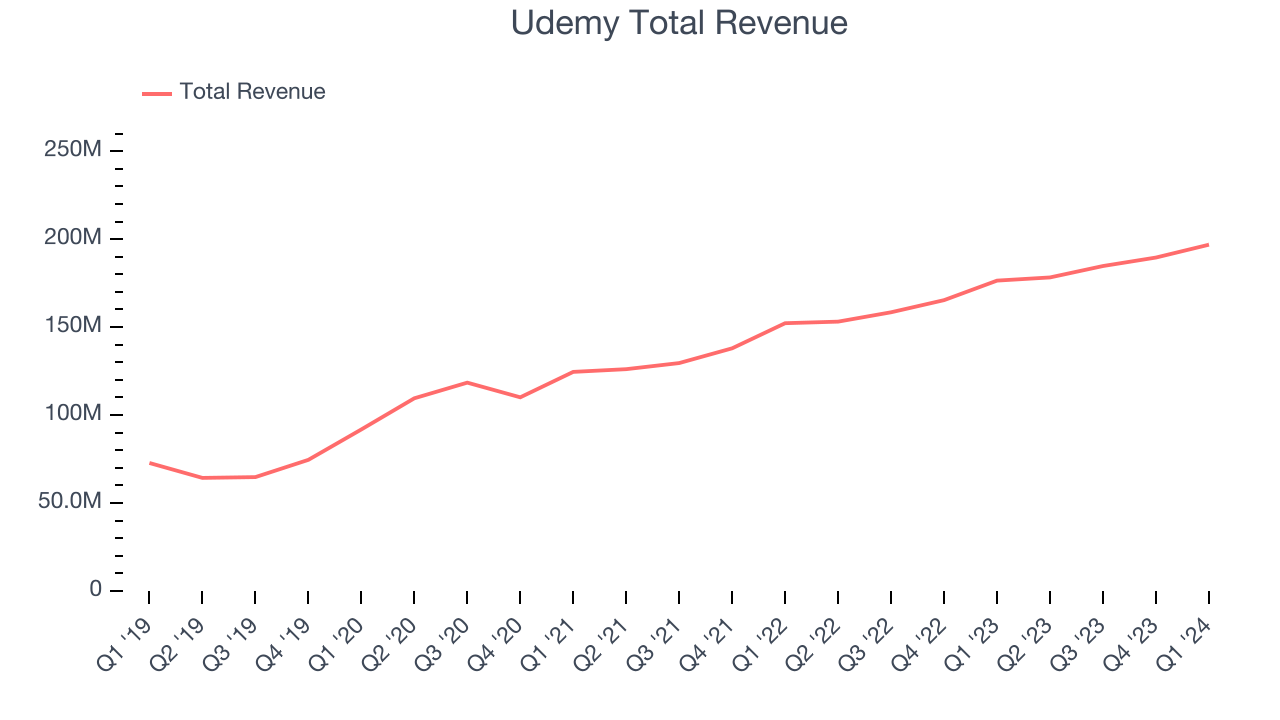
Guidance for the next quarter indicates Udemy is expecting revenue to grow 8.6% year on year to $193.5 million, slowing from the 16.4% year-on-year increase it recorded in the comparable quarter last year. Ahead of the earnings results, analysts were projecting sales to grow 10.5% over the next 12 months.
Usage Growth
As a subscription-based app, Udemy generates revenue growth by expanding both its subscriber base and the amount each subscriber spends over time.
Over the last two years, Udemy's active buyers, a key performance metric for the company, grew 3% annually to 1.44 million. This is one of the lowest rates of growth in the consumer internet sector.
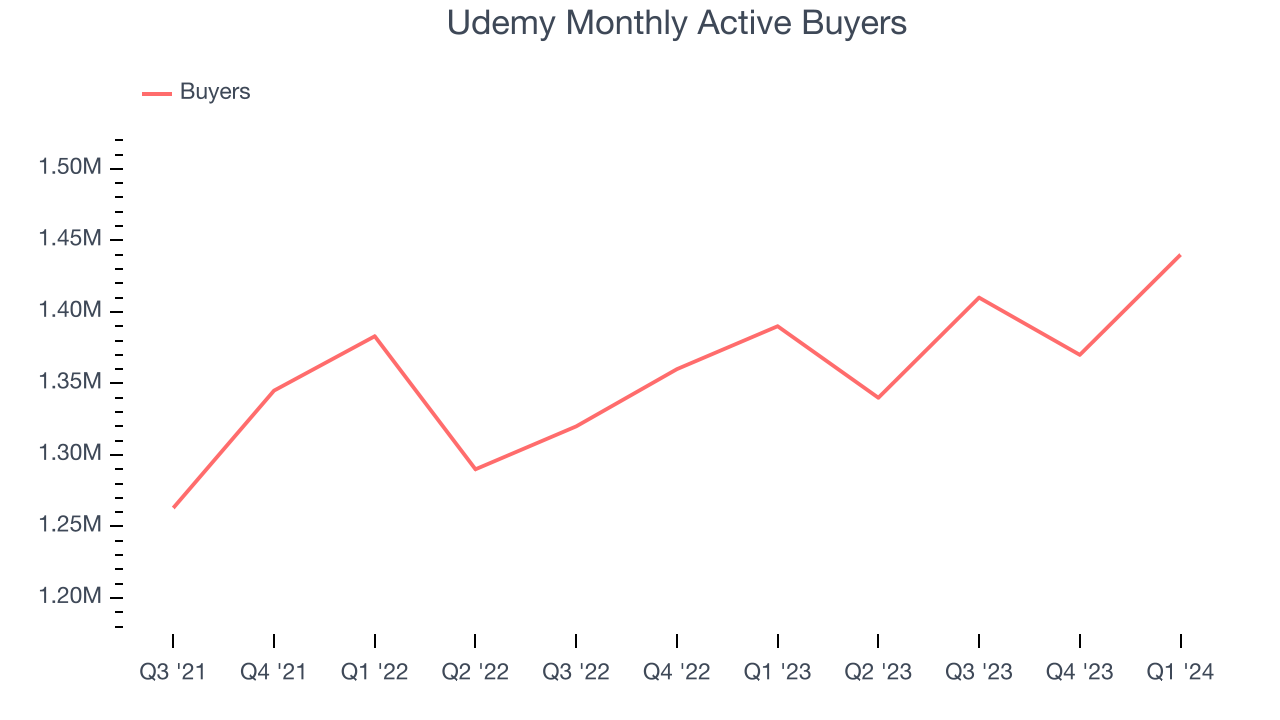
In Q1, Udemy added 50,000 active buyers, translating into 3.6% year-on-year growth.
Revenue Per Buyer
Average revenue per buyer (ARPB) is a critical metric to track for consumer internet businesses like Udemy because it measures how much the average buyer spends. ARPB is also a key indicator of how valuable its buyers are (and can be over time).
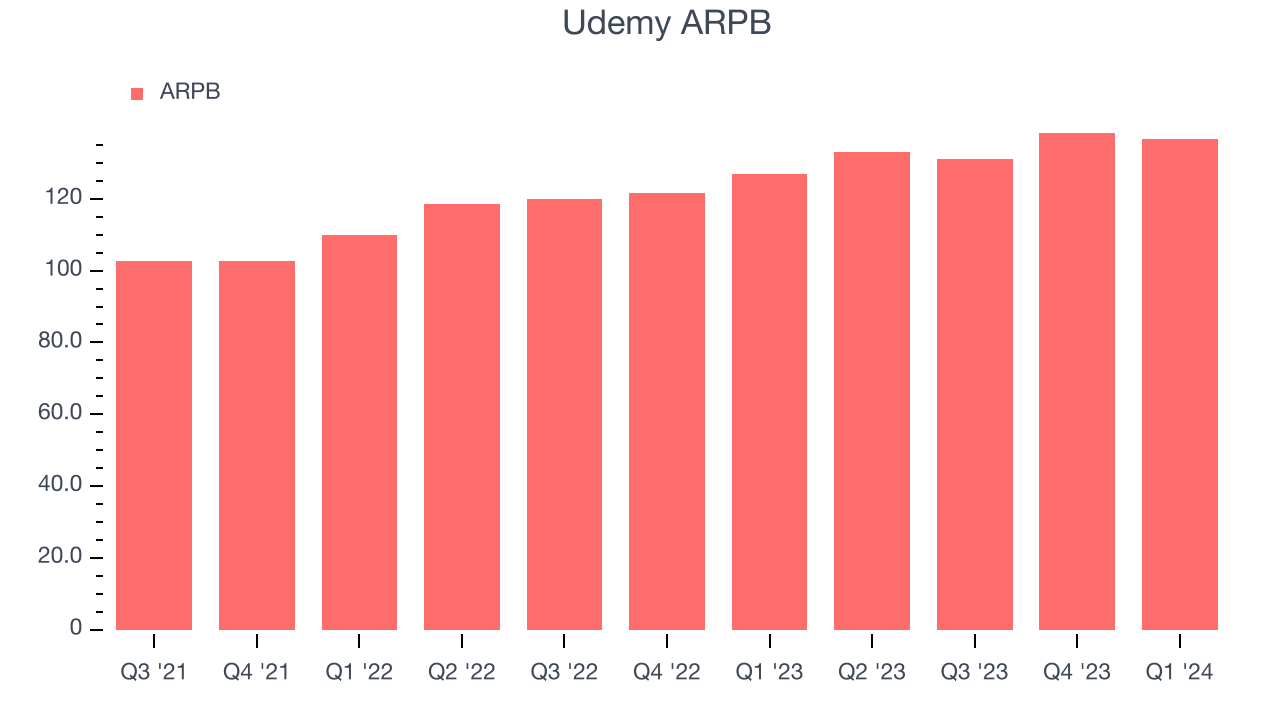
Udemy's ARPB growth has been impressive over the last two years, averaging 13.4%. The company's ability to increase prices while growing its active buyers demonstrates its platform's value, as its buyers continue to spend more each year. This quarter, ARPB grew 7.7% year on year to $136.70 per buyer.
Pricing Power
A company's gross profit margin has a major impact on its ability to exert pricing power, develop new products, and invest in marketing. These factors may ultimately determine the winner in a competitive market, making it a critical metric to track for the long-term investor.
Udemy's gross profit margin, which tells us how much money the company gets to keep after covering the base cost of its products and services, came in at 61.2% this quarter, up 4.7 percentage points year on year.
For internet subscription businesses like Udemy, these aforementioned costs typically include customer service, data center and infrastructure expenses, and royalties and other content-related costs if the company's offering includes features such as video or music services. After paying for these expenses, Udemy had $0.61 for every $1 in revenue to invest in marketing, talent, and the development of new products and services.
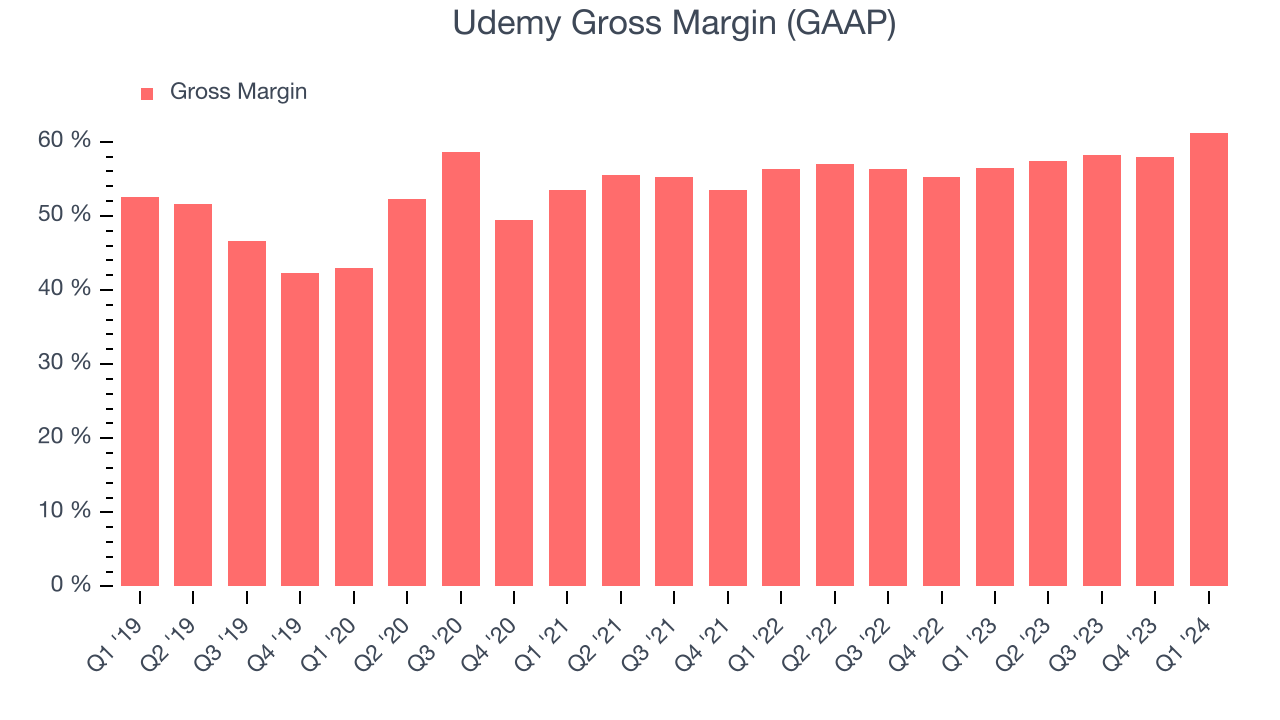
Udemy's gross margins have been trending up over the last year, averaging 58.7%. These margins are around that of a typical consumer internet business, but Udemy's rising margins may indicate improving pricing power or scale advantages over costs.
User Acquisition Efficiency
Consumer internet businesses like Udemy grow from a combination of product virality, paid advertisement, and incentives (unlike enterprise software products, which are often sold by dedicated sales teams).
It's very expensive for Udemy to acquire new users as the company has spent 73.7% of its gross profit on sales and marketing expenses over the last year. This inefficiency indicates a highly competitive environment with little differentiation between Udemy and its peers.
Profitability & Free Cash Flow
Investors frequently analyze operating income to understand a business's core profitability. Similar to operating income, adjusted EBITDA is the most common profitability metric for consumer internet companies because it removes various one-time or non-cash expenses, offering a more normalized view of a company's profit potential.
This quarter, Udemy's EBITDA came in at $6.46 million, resulting in a 3.3% margin. The company has also shown above-average profitability for a consumer internet business over the last four quarters, with average EBITDA margins of 2.7%.
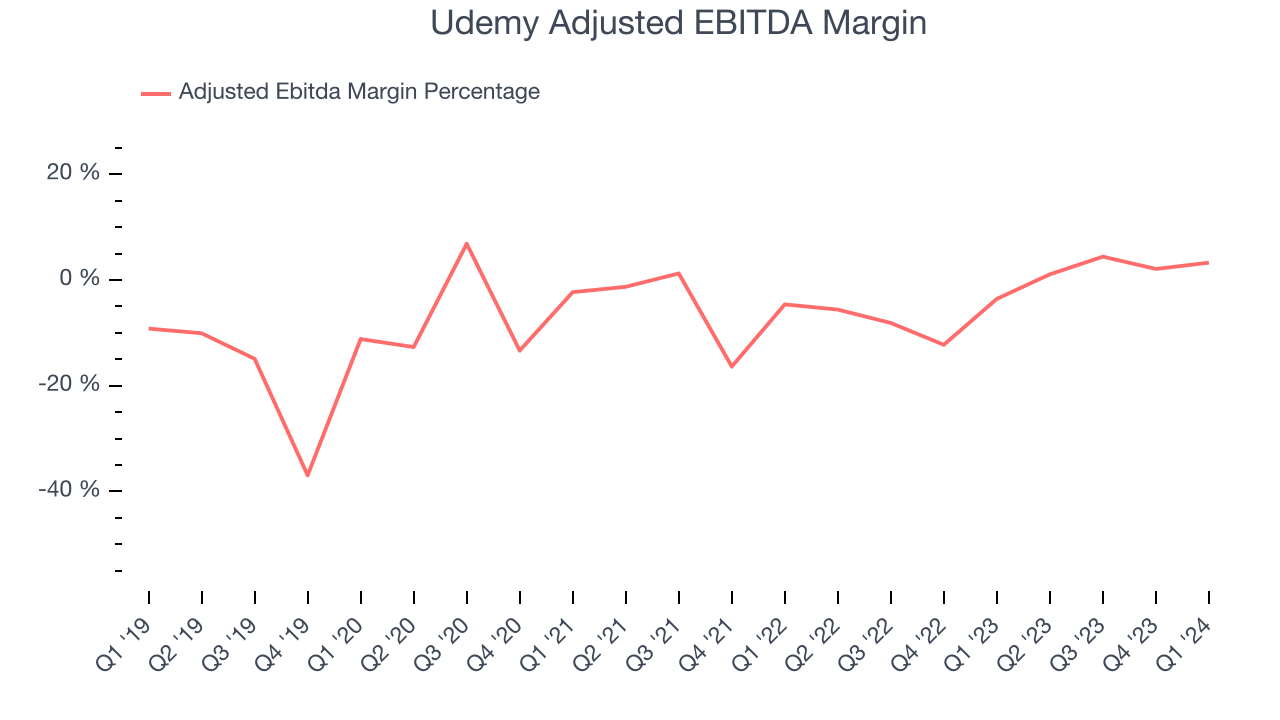
If you've followed StockStory for a while, you know that we emphasize free cash flow. Why, you ask? We believe that in the end, cash is king, and you can't use accounting profits to pay the bills. Udemy's free cash flow came in at $17.51 million in Q1, turning positive year on year.
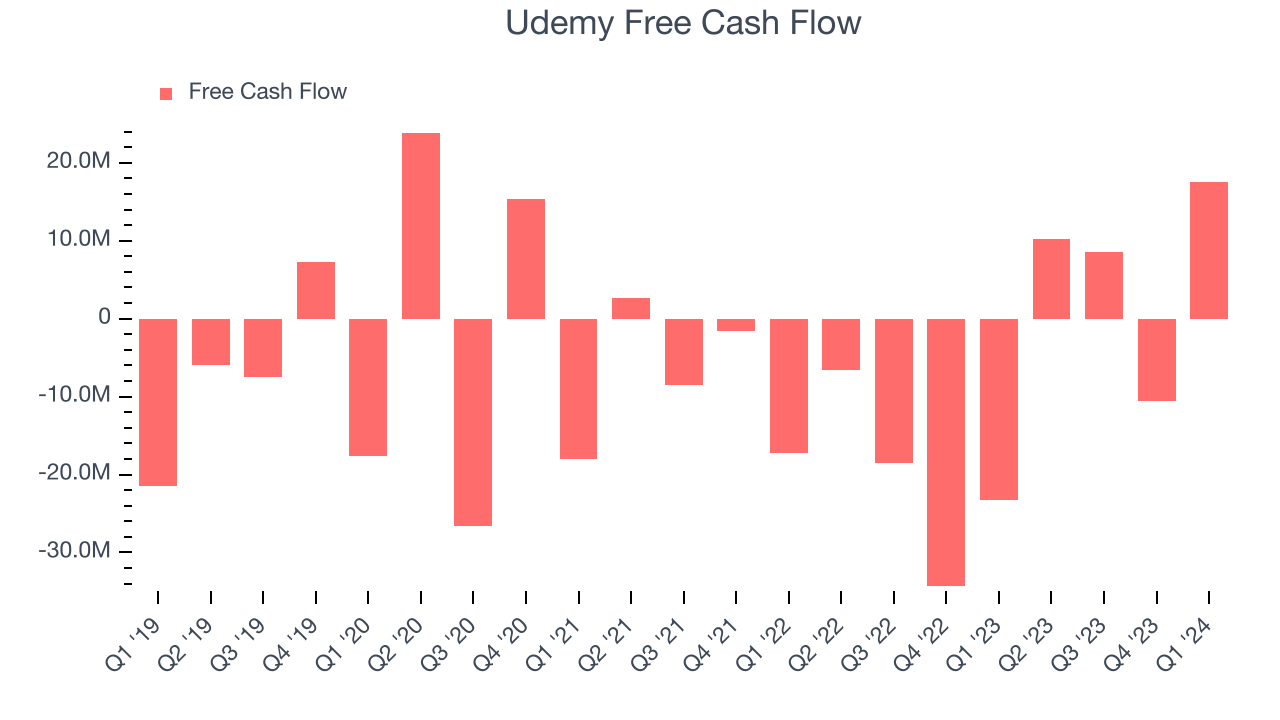
Udemy has generated $25.69 million in free cash flow over the last 12 months, or 3.4% of revenue. This FCF margin stems from its asset-lite business model and enables it to reinvest in its business without depending on the capital markets.
Key Takeaways from Udemy's Q1 Results
ARPU has increased in Q1 and Udemy posted positive cash flow - those were the good news. On the other hand its revenue guidance for next quarter missed analysts' expectations and user growth is slow. Overall, we feel this was a mixed quarter for Udemy. The stock is up 5% after reporting and currently trades at $10.38 per share.
Is Now The Time?
Udemy may have had a bad quarter, but investors should also consider its valuation and business qualities when assessing the investment opportunity.
We cheer for everyone who's making the lives of others easier through technology, but in the case of Udemy, we'll be cheering from the sidelines. Although its revenue growth has been decent over the last three years, Wall Street expects growth to deteriorate from here. And while its increasing ARPU shows the growing value of its platform, the downside is its sales and marketing spend is very high compared to other consumer internet businesses. On top of that, its active buyers have declined.
Udemy's price/gross profit ratio based on the next 12 months is 3.2x. While there are some things to like about Udemy and its valuation is reasonable, we think there are better opportunities elsewhere in the market right now.
Wall Street analysts covering the company had a one-year price target of $15.07 per share right before these results (compared to the current share price of $10.38).
To get the best start with StockStory check out our most recent Stock picks, and then sign up to our earnings alerts by adding companies to your watchlist here. We typically have the quarterly earnings results analyzed within seconds of the data being released, and especially for the companies reporting pre-market, this often gives investors the chance to react to the results before the market has fully absorbed the information.
